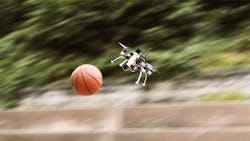Researchers from the University of Zurich have demonstrated a drone that can detect and avoid fast-moving objects
ZURICH - Drones can do many things, but avoiding obstacles is not their strongest suit yet – especially when they move quickly. Although many flying robots are equipped with cameras that can detect obstacles, it typically takes from 20 to 40 milliseconds for the drone to process the image and react. It may seem quick, but it is not enough to avoid a bird or another drone, or even a static obstacle when the drone itself is flying at high speed. This can be a problem when drones are used in unpredictable environments, or when there are many of them flying in the same area.
In order to solve this problem, researchers at the University of Zurich have equipped a quadcopter (a drone with four propellers) with special cameras and algorithms that reduced its reaction time down to a few milliseconds – enough to avoid a ball thrown at it from a short distance. The results, published in the journal Science Robotics, can make drones more effective in situations such as the aftermath of a natural disaster.
“For search and rescue applications, such as after an earthquake, time is very critical, so we need drones that can navigate as fast as possible in order to accomplish more within their limited battery life,” explains Davide Scaramuzza, who leads the Robotics and Perception Group at the University of Zurich as well as the NCCR Robotics Search and Rescue Grand Challenge. “However, by navigating fast drones are also more exposed to the risk of colliding with obstacles, and even more if these are moving. We realized that a novel type of camera, called Event Camera, are a perfect fit for this purpose.”
In the future, the team aims to test this system on an even more agile quadrotor. “Our ultimate goal is to make one day autonomous drones navigate as good as human drone pilots. Currently, in all search and rescue applications where drones are involved, the human is actually in control. If we could have autonomous drones navigate as reliable as human pilots we would then be able to use them for missions that fall beyond line of sight or beyond the reach of the remote control,” says Davide Falanga, the PhD student who is the primary author of the article.
The work was funded by the Swiss National Science Foundation through the National Center of Competence in Research (NCCR) Robotics.
